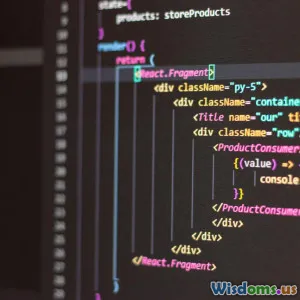
Creating Effective Development Teams
7 min read Master the art of creating effective development teams with actionable strategies and best practices for the tech industry. (0 Reviews)
Introduction
In the fast-paced world of technology and programming, the success of software projects largely hinges on the effectiveness of development teams. The era of isolating individuals in silos is behind us. Today, progress and innovation emerge from diverse minds collaborating towards a common goal. But what truly makes a development team effective? This article delves into the strategies and components necessary for building high-functioning development teams, backed by examples and practices from industry leaders.
Understanding Team Dynamics
The Importance of Team Composition
The groundwork for a successful development team starts with its composition. Diverse teams that bring together members with various skills, backgrounds, and perspectives foster innovation. For instance, a software firm may blend front-end developers, back-end developers, UI/UX designers, and quality assurance engineers to create a well-rounded team. Each member contributes unique insights, leading to creative problem-solving.
Example: GitHub's Octocat Team
Consider the Octocat team at GitHub, which exemplifies diversity in roles. With front-end developers collaborating alongside designers, they merge technical proficiency with creativity, leading to aesthetically driven, functional user interfaces that resonate with developers and non-developers alike.
Setting Clear Roles and Responsibilities
Inevitably, clarity in roles is paramount. When team members understand their responsibilities, it enhances focus and accountability. Google’s Project Aristotle emphasizes that effective teams explicitly define roles, fostering a heightened sense of ownership. For example, within a Scrum team, the Developer writes code, the Product Owner defines user stories, and the Scrum Master facilitates the process. Such clarity allows individuals to excel and minimizes overlap, leading to efficiency.
Building Communication Bridges
Emphasizing Open Communication
Effective communication stimulates progress. Development teams should embrace transparency, making tools like Slack or Microsoft Teams indispensable for collaboration. These platforms not only foster communication but also create an environment where ideas flow without barriers.
Screenshot Example: Slack for Development Team Communication
Imagine a scenario in which developers share code snippets in Slack channels, discussing potential improvements or blockers in real-time. This rapid exchange boosts morale and encourages collaboration, as all members stay informed about updates and challenges.
Regular Check-ins and Standup Meetings
Daily or bi-weekly stand-up meetings act as effective touchpoints for team members to share project status, obstacles, or next steps. According to a study from Harvard Business Review, regular check-ins help teams align their objectives, leading to a 25% increase in productivity. During these meetings, brief discussions allow team members to not only leverage support but also fosters a collective sense of progress.
Fostering a Collaborative Environment
Enabling Knowledge Sharing
Encouraging knowledge sharing creates a stronger foundation. Implementing peer code reviews or pair programming sessions enables developers to learn from each other while also enhancing code quality and reducing bugs. For example, the practice at software companies like Atlassian has led to a culture where developers eagerly participate in code reviews, promoting mutual respect and skill enhancement.
Using Project Management Tools
Adopting project management tools like JIRA, Asana, or Trello centralizes work tracking and progress monitoring, fading the limits of individual assignments. Tools help create transparency with everyone knowing what tasks need attention. This communal visibility allows team members to reallocate efforts toward lagging areas.
Embracing Agile Methodologies
Iterative Development and Feedback Loops
An iterative approach, as seen in Agile Methodologies like Scrum or Kanban, allows teams to adapt swiftly and effectively. For instance, an Agile team might work in sprints, delivering increments of their product every couple of weeks and gathering user feedback. This process aligns development closely with customer needs, maximizing efficiency and satisfaction.
Emphasizing Retrospectives
Under the Agile framework, retrospectives create an avenue for team reflection and improvement. At the end of each iteration, Agile teams are encouraged to discuss what went well and areas needing refinement. This culture of continual improvement cultivates a growth mindset, promoting accountability and collaboration among team members.
Measuring Success
Establishing KPIs for Development Teams
After deployment, measuring the success of projects is critical. Establish Key Performance Indicators (KPIs) like code quality, velocity in completing tasks, and customer satisfaction scores resulting from iterative tests. According to a study by McKinsey, projects that harness well-defined KPIs can enhance their output by as much as 20%.
Celebrating Milestones
Recognizing achievements motivates teams. Simple celebrations, like shout-outs in meetings, team lunches, or achievement badges can enhance morale. A good example is the engineering teams at Slack, where they celebrate launches and significant project completions to foster motivation and appreciation across the board.
Conclusion
Creating effective development teams is both an art and a science. Mastering the delicate balance of diverse skill sets and personalities, while fostering open communication, collaboration, and a sense of accountability, can lead to elevated creativity and heightened productivity. Moreover, by adopting Agile methodologies, promoting ongoing learning, and celebrating successes, organizations will pave the way for innovation, efficiency, and powerful software solutions. These principles will not only ensure individual growth but will also maintain competitive advantage in the ever-evolving landscape of technology and programming. So, take the plunge into enhancing your team dynamics and readiness to face the challenges of modern software development today.
Rate the Post
User Reviews
Popular Posts





















